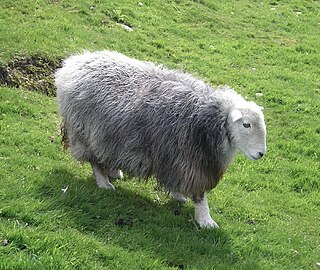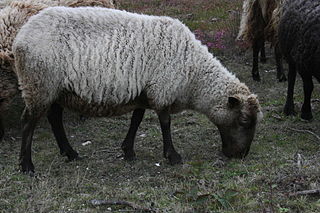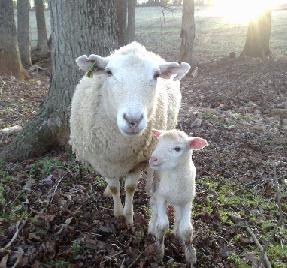
The Herdwick is a breed of domestic sheep native to the Lake District in North West England. The name "Herdwick" is derived from the Old Norse herdvyck, meaning sheep pasture. Though low in lambing capacity and perceived wool quality when compared to more common commercial breeds, Herdwicks are prized for their robust health, their ability to live solely on forage, and their tendency to be territorial and not to stray over the difficult upland terrain of the Lake District. It is considered that up to 99% of all Herdwick sheep are commercially farmed in the central and western Lake District.

The Manx Loaghtan ( loch-tan) is a rare breed of sheep native to the Isle of Man. It is sometimes spelled as Loaghtyn or Loghtan. The sheep have dark brown wool and usually four or occasionally six horns.

The Soay sheep is a breed of domestic sheep descended from a population of feral sheep on the 100-hectare (250-acre) island of Soay in the St Kilda Archipelago, about 65 kilometres (40 mi) from the Western Isles of Scotland. It is one of the Northern European short-tailed sheep breeds.

The Toggenburg or Toggenburger is a Swiss breed of dairy goat. Its name derives from that of the Toggenburg region of the Canton of St. Gallen, where it is thought to have originated. It is among the most productive breeds of dairy goat and is distributed world-wide, in at least fifty countries in all continents.

The Jacob is a British breed of domestic sheep. It combines two characteristics unusual in sheep: it is piebald—dark-coloured with areas of white wool—and it is often polycerate or multi-horned. It most commonly has four horns. The origin of the breed is not known; broken-coloured polycerate sheep were present in England by the middle of the seventeenth century, and were widespread a century later. A breed society was formed in 1969, and a flock book was published from 1972.

The Shropshire breed of domestic sheep originated from the hills of Shropshire, and North Staffordshire, England, during the 1840s. The breeders in the area used the local horned black-faced sheep and crossed them with a few breeds of white-faced sheep. This produced a medium-sized polled (hornless) sheep that produced good wool and meat. In 1855 the first Shropshires were imported into the United States (Virginia). This breed is raised primarily for meat.

The Icelandic sheep is a breed of domestic sheep. The Icelandic breed is one of the Northern European short-tailed sheep, which exhibit a fluke-shaped, naturally short tail. The Icelandic is a mid-sized breed, generally short-legged and stocky, with face and legs free of wool. The fleece of the Icelandic sheep is dual-coated and occurs in white and a variety of other colors, including a range of browns, grays, and blacks. They exist in both horned and polled strains. Generally left unshorn for the winter, the breed is very cold-hardy. Multiple births are very common in Icelandic ewes, with a lambing percentage of 175–220%. A gene also exists in the breed called the Þoka gene, and ewes carrying it have been known to give birth to triplets, quadruplets, quintuplets, and even sextuplets on occasion.

The Barbados Black Belly is a breed of domestic sheep from the Caribbean island of Barbados. Although it is likely the Barbados Blackbelly has African ancestry, there seems to be clear evidence that the breed, as seen today, was developed by the people on the island from sheep brought by ships fairly early in the period after Europeans first arrived. This breed is raised primarily for meat. It is widely distributed, with populations in twenty-five countries in the Americas, Asia and Europe. It is most abundant in the Caribbean region, in Mexico and in Peru. In 2015 the total world population was estimated at about 158,000. In 2014, the US reported 1,971 registered sheep.

The Rough Fell is an upland breed of sheep, originating in England. It is common on fell and moorland farms, its distribution embracing a large proportion of South Cumbria, parts of the West Riding of Yorkshire, North Lancashire and, more recently, upland parts of Devon. It is very hardy and, as its name suggests, has proved to be well-suited to endure the hardships of exposed and high moorland and mountains. It is one of the largest mountain breeds in Britain. This breed is raised primarily for meat.
The Finnish Landrace, Finn or Finnsheep is a breed of domestic sheep native to Finland. It is one of several Northern European short-tailed sheep breeds, but is notable for its high incidence of multiple births – it is common for a ewe to have three, four, or even five lambs at once.

The Dorset Horn is an endangered British breed of domestic sheep. It is documented from the seventeenth century, and is highly prolific, sometimes producing two lambing seasons per year. Among British sheep, it is the only breed capable of breeding throughout the winter.

The Shetland is a small, wool-producing breed of sheep originating in the Shetland Isles, Scotland but is now also kept in many other parts of the world. It is part of the Northern European short-tailed sheep group, and it is closely related to the extinct Scottish Dunface. Shetlands are classified as a landrace or "unimproved" breed. This breed is kept for its very fine wool, for meat, and for conservation grazing.

The Roslag sheep is a breed of endangered domesticated sheep that originated in and is almost exclusively found in Sweden.

The Gotland, also called the Gotland Pelt, is a breed of domestic sheep named for the Swedish island of Gotland. A breed of Northern European short-tailed sheep, they are thought to be the product of crossbreeding between the native landrace of the island — called the Gute — with Karakuls and Romanovs during the 1920s and 1930s.

The Northern European short-tailed sheep are a group of traditional sheep breeds or types found in northern Europe, mainly in the British Isles, Scandinavia, Greenland and the area around the Baltic. They are thought to be derived from the first sheep brought to Europe by early farmers, and for thousands of years they were the only type of sheep kept in northern Europe. They are hardy sheep, adapted to harsh environments, but they are small and have been replaced in most areas with later types of larger, long-tailed sheep.

The White Polled Heath is a small breed and landrace of North German sheep and belongs to the Heidschnucke family, part of the Northern European short-tailed sheep group. However, unlike the other Heidschnucke types, it is entirely white and polled (hornless).

The Meatmaster is a breed of domestic sheep native to South Africa. Bred in the early 1990s from various hair sheep breeds, the Meatmaster was created with the goal of improving the meat characteristics of African fat-tailed sheep breeds. The fat-tailed sheep had various advantageous characteristics such as hardiness and suitability for desert life, but was slow to mature, had a poor distribution of fat and lacked the muscling of the hind quarters of European breeds. The composite breed increased the amount of muscle and had a better distribution of fat but retained the hair coat and other desirable traits such as resistance to tick-borne diseases and a good flocking instinct.
The Eliottdale is a breed of domestic sheep originating from Tasmania. It is a carpet wool breed raised primarily for its wool. Due to the amount of wool grown by the Eliottdale, it needs to be shorn twice per year.

The Polled Dorset is an American breed of domestic sheep. It is a polled (hornless) variant of the British Dorset Horn. It was developed at the North Carolina State University Small Ruminant Unit in the 1950s after a genetic mutation led to the birth of a polled ram. After some years of breeding work, a true-breeding polled strain was established.
The Greenlandic sheep is a breed of domestic sheep. The Greenlandic breed is one of the Northern European short-tailed sheep, which exhibit a fluke-shaped, naturally short tail. The Greenlandic is a mid-sized breed, generally short-legged and stocky, with face and legs free of wool. The fleece of the Greenlandic sheep is dual-coated and comes in white as well as a variety of other colors, including a range of browns, grays, and blacks. They exist in both horned and polled strains. Generally left unshorn for the winter, the breed is very cold-hardy. Multiple births are very common in Greenlandic ewes, with a lambing percentage of 150% - 190%.






















